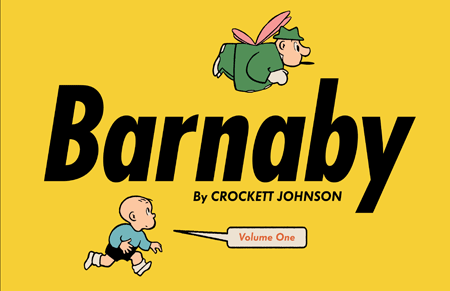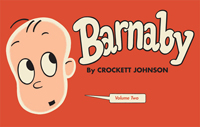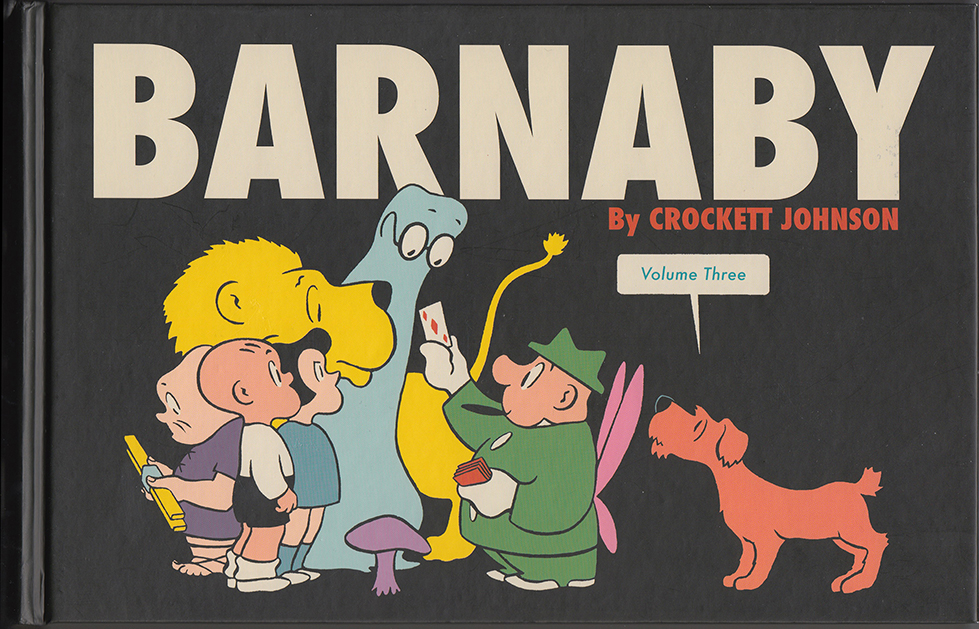Good news: I’ve finished the Afterword and Notes for Crockett Johnson‘s Barnaby Volume Four: 1948-1949 (co-edited with Eric Reynolds, and coming next year from Fantagraphics)! Revision to first sentence: we might put “finished” in quotation marks because there are a few references that stump me. Perhaps you can help?
At the back of each book, I provide a catalogue of the comic strip’s many allusions – some of which are topical, and others of which reflect Johnson’s wide range of interests. For those unfamiliar with it, I should add that Barnaby (1942-1952) mixed fantasy and satire in its many stories of its five-year-old title character and Mr. O’Malley – Barnaby’s loquacious, endearing con-artist of a fairy godfather. Read all about them in the first three books! :-)
 |
 |
 |
For Volume Four, here are a few allusions that elude me. Any thoughts? Any who help will of course be credited in the published book, of course. I realize that a mention in the Acknowledgments is not a Big Prize, but in my experience readers of Barnaby rather enjoy these sorts of esoteric questions in and of themselves. Thanks in advance for any ideas or suggestions you might have!
UPDATE, 29 and 30 June: Mere hours after posting this (and thanks to Mark Newgarden for sharing this query via his Facebook page), I already had a definitive answer to the last item and a possible answer to the penultimate one. By June 30, more suggestions arrived. Thanks to all who answered. I have what I need! (I don’t think we’ve quite pinned down the play, but we may be as close as we’ll get…)
The O’Malley Sales Method improves upon the old technique of merely suggesting the ailment (17 Mar. 1948).
Who came up with the suggestion? Lots of companies create the problem that they then ameliorate, but I wonder if O’Malley is referring to a particular person, advertising agency, or company.
UPDATE, 30 June: Thanks to Peter Sattler (on Facebook), I now have an answer. Here is what I have written:
This strip may reference a once-common way of selling vacuum cleaners. The salesman arrives at your home with a Hoover or Kirby, unpacks the vacuum and its attachments. As part of his demonstration, he throws flour or dirt on the living room carpet (or rug), and then shows how the vacuum cleaner makes that flour or dirt disappear.
Thanks, Peter!
ad for the book about how to double a white collar income with an acre of land (26 June 1948).
Also referenced in the 25 June strip (“double your parents’ income, the ad says”), this seems like it might be a real book – an actual scam from the period. If it is, I haven’t been able to find it.
UPDATE, 30 June: Thanks to Steven Thompson (via Facebook), I now have answer (below!)
Also referenced in the 25 June strip (“double your parents’ income, the ad says”), this is likely a reference to advertisements for William B. Duryee’s Farming for Security (McGraw-Hill, 1943) or M.G. Kains’ Five Acres and Independence (Greenberg, 1940). Both books promised to teach people to farm – a claim that would have aroused the skepticism of Johnson, who had mixed results with his own garden.
my play portrays human suffering as the product of civilization, time and space. The poor frustrated peasant in “The Peon’s Plight” could be you or me or Barnaby – (29 July 1948).
If Johnson is mocking a specific play or plays (and I suspect he is), I have not been able to determine which one. Thornton Wilder’s Pulitzer-Prize-winning The Skin of Our Teeth (1942) is a possible candidate. Its main characters, the Antrobus family, personify humankind; in each act, they face the possibility of their (and therefore humankind’s) demise. Strongly influenced by Marx, Johnson saw human suffering as a byproduct of capitalist exploitation. He would have disliked Wilder’s use of history as allegory (or “modern symbolic drama,” as The Peon’s Plight is described on 23 July), which he would have seen as lacking analytical rigor.
UPDATE, 29 June: John Wendler (via Facebook) notes that the title, The Peon’s Plight, may be derived from John Bunyan’s Christian allegory, The Pilgrim’s Progress (1678). That’s a good point.
St. John Saintsbury-Wough (17 Aug. 1948).
Is Johnson mocking a specific critic or simply a type of critic? If it’s someone in particular, I don’t know who.
UPDATE, 29 and 3o June: Via Facebook, Ray Davis and Corey Creekmur both suggested Alexander Woollcott (1887-1943), which is a possibility. I rewrote it once. Then, I received more suggestions from Pete Kunze, Peter Sattler, and Rob King. So, I rewrote the note a second time. Here it is:
This character is likely an amalgam of several critics. The name itself recalls some of English novelist (and journalist) Evelyn Waugh’s full name, Arthur Evelyn St. John Waugh (1903-1966). Another possible inspiration for the name and the character is St. John Ervine (1883-1971), the Irish-English dramatist and critic. (Ervine was born in Belfast, but lived and worked in London.) The source of “Saintsbury” may be the English scholar and critic George Saintsbury (1845-1933).
Two American critics may also be woven into this composite character. St. John Saintsbury-Wough may be based not on Alexander Woollcott (1887-1943), but on the idea of Alexander Woollcott. Both he and Saintsbury-Wough were known for being highbrow, tough, idiosyncratic, and famous. I say the idea of Woollcott because he was famous via his portrayals in popular culture. He appears in altered form as Sheridan Whiteside in George S. Kaufman and Moss Hart’s The Man Who Came to Dinner, portrayed in both the stage (1939) and film (1942) versions by Monty Woolley. Woollcott is also an inspiration for Waldo Lydecker in Laura, which was a Vera Caspary serialized story (1942), then a novel (1943), Otto Preminger film (1944, with Clifton Webb as Lydecker), radio play (1945, 1948), and stage play (1945).
However, Woollcott was dead by 1948. But George Jean Nathan (1882-1958) – another famous American critic – was active and influential. An appearance by him at a production like this would have elicited a similarly awed reaction. So, he may be another source for Johnson’s character.
oo–MOONbeams beHIND you–oo (14 Dec. 1948).
I have not been able to locate this song. As it is rendered typographically, it suggests a rude pun – “MOONbeams beHIND.” This makes me wonder if it’s a drinking song, playing perhaps on the stereotype of the Irish policeman. Thanks to Luke Jaeger (via Facebook, when Mark Newgarden shared this query), I at last have an answer to this. Here’s what I’ve written:
It should be moonlight and not moonbeams. Ausdauer is slightly misremembering a lyric from Noel Coward’s “Someday I’ll Find You,” the chorus of which begins: “Someday I’ll find you, / moonlight behind you.” The song first appeared in his play Private Lives (1930), and later became the theme for the long-running radio show Mr. Keen, Tracer of Lost Persons (1937-1955).
Luke is now in the Acknowledgments, as are all the people who have helped. Thanks, everyone!
Note: these are not the best copies of these strips. But Fantagraphics always gets the best source material available and cleans them up when necessary. So, you will see better quality reproductions in the book!
AND: Comic-Con! Â Barnaby Volume Three has been nominated for a 2017 Eisner Award. Will it prevail, or will I become a three-time Eisner loser? Stay tuned! And, if you’ll be at Comic-Con, well… so will I! See you at the Fantagraphics booth, perhaps? (I’m not working the booth, mind you. But I will be there. Might do a signing – no details on that yet.)
Related posts (on this blog)
- Gosh! Barnaby Volume Three (1946-1947) is here! (27 Apr. 2016). Announcement of the appearance of Volume Three, with photos.
- Crockett Johnson’s Elusive Allusions: Errata for Barnaby Volume 2 (23 Jun. 2014). This is how I know that at least some people are reading my glossaries at the back of each volume. Astute readers caught a couple of errors in Volume 2!
- Crockett Johnson’s Barnaby Volume Two (1944-1945) is here! (19 May 2014). Photos of the second volume, fresh out of the box!
- Barnaby at Comic-Con (15 July 2013)
- Barnaby, Small Scandinavian Investors, and Dapper Dan: Can you help identify these allusions? UPDATE: Mysteries Solved! (9 Apr. 2013). I crowd-sourced some allusions before. Since that was successful, I’m trying again in this blog post….
- Shrdlu, Minsky, Burke & Hare (26 Jan. 2013)
- Barnaby, Vol. 1 (31 Dec. 2012)
- Barnaby on stage, version 2 (7 Nov. 2012). The program for a performance of Robert and Lilian Masters’ 1948 play.
- Cushlamochree! Barnaby on stage! (20 Apr. 2011). Some photos and images from Jerome Chodorov’s 1946 play.
- Barnaby on the radio (28 Nov. 2010). The 1945 radio adaptation, with full audio.
- Barnaby. In color. (11 Nov. 2010) One of the Sunday strips.
- Merry Christmas from Mr. O’Malley (24 Dec. 2010). Another Sunday strip.
- Color Sunday Barnaby: March comes in like… (27 Feb. 2010). And another one.
- Here Comes the Barnaby Truck (13 Feb 2011). Photo of a Chicago Sun truck featuring a Barnaby ad on the side.
- Barnaby Fan Club (31 Jan. 2011). A membership card designed to promote the Del Rey reprints (1985-1986)
- The Debut of Crockett Johnson’s Barnaby (8 Nov. 2010). Some ads for Barnaby. They ran in PM the week before the strip’s April 1942 debut.
- The Complete Barnaby: Coming Soon! (2 Dec. 2010). An announcement for the publication of The Complete Barnaby Volume 1. Bonus: an advertisement for Barnaby (Holt, 1943).
- Happy Birthday, Crockett Johnson! (20 Oct. 2010) Features an advertisement for Barnaby and Mr. O’Malley (Holt, 1944).











